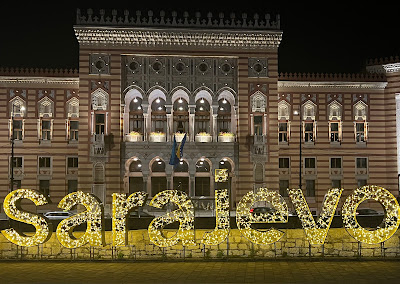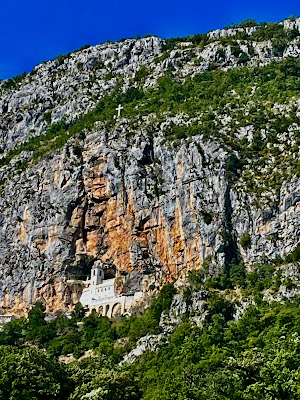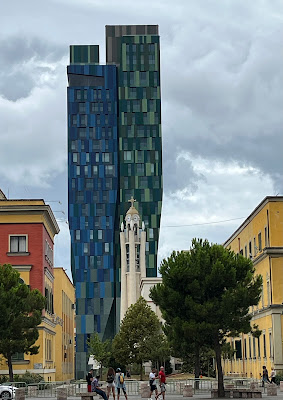It was time to move on from the familiar embrace of Hungary and to explore further afield. Transitioning from home into the unknown, entering that liminal space, is always a curious blend of excitement and trepidation - as we move from certainty and stasis to fluctuation and adventure.
And thus it was time for a road trip! Given the relentless European summer heatwave, my duffle bag is half empty, music is downloaded, and my nostalgic peanut butter and jam sandwich is ready for the long drive ahead.
Várpalota, Hungary to Trogir, Croatia (via Zadar, Croatia) is 675 kilometers. Trogir to Split is a short ferry or a 27 km drive away. Trogir is the more tranquil of the two. Both are stunning - architecturally and in terms of landscape. From intensely ornate medieval cathedrals to gorgeous beaches, these two Croatian cities on the Adriatic Sea are superb destinations to explore.
While the joy of swimming in warm, secluded, protected waters is easy to understand, the grotesque medieval carvings on the 13th century portal of St. Lawrence's Cathedral in Trogir is baffling. The contrast of the cathedral's sublime, sacred interior spaces with the external deranged iconography is jarring. And maybe that's the very purpose of these otherworldly creatures: leave the external world of materialism, temptation, evil and ego on the outside, as you enter infinite, spiritual space inside the church.
I leave Croatia and my travel companions behind to continue my Balkan adventures as a solo traveller - perhaps travel in its most purest form.
Arriving late in the evening by bus from Trogir, Croatia to Sarajevo, Bosnia and Hercegovina wasn't straightforward. The bus terminal was closed, public transport was nowhere to be found, and taxi drivers were wildly negotiating fees at breakneck speed which my sleepy brain was having trouble processing. A persistent yet amicable driver and I finally connected and we found my hotel in a dark, narrow alleyway next to a river. It was midnight. The very pleasant elderly gentleman who greeted me was the father of the guesthouse owner. As a weary traveller at the end of a long day, I was glad to be embraced by his genuinely warm hospitality.
Sarajevo captivated me completely. I simply was incapable of leaving this magical city. Echos reverberating back to its not too distant tragic, genocidal history are undeniably present, yet the city's triumphant and joyous emergence from the collective trauma is hopeful and inspirational - perhaps especially now as we again are confronting these darkest dimensions of humanity.
One of two hundred Roses of Sarajevo.
They mark a spot where mortar fire killed at least three people during the Siege of Sarajevo between April 5, 1992 to February 29, 1996, during which nearly 14,000 people were killed, including 5,434 civilians. The fragmentation patterns left by the explosions were later filled in with red resin as memorials to those who lost their lives during the Bosnian War. As I walk about enjoying the city's vibrant post war energy, it feels important to have these reminders of the pain humanity is capable of perpetrating - as a way of hopefully preventing subsequent atrocities. Sadly, the genocide we see unfolding in Gaza, Palestine these days tells me that we're still not ready to transcend violent tribal attachments.
The unique East meets West vibe of the city - striking me like Budapest meets Istanbul - is a pleasure to explore. In fact strolling along Ferhadija Street, one can literally take a single step and be noticeably transported from a European to an Asian urban landscape, at the point inscribed, "Sarajevo - Meeting of Cultures".
Taking the Sarajevo Cable car up to Mt. Trebević made for a fine afternoon. Hiking amidst cool, pine fresh trails and the views of the city below are lovely. I had a chance encounter where the forest trail led to a viewpoint from where one could take in the charming urban landscape below. A gentleman slightly limping and accompanied by his daughter were speaking English and I said, "Hello". He recounted how he was a small boy when he was with the first family to be airlifted by the UN out of Sarajevo after his home was amongst those bombed by Bosnian Serbs - from the very surrounding mountains we were now hiking in. It was during the 1992 to 1995 siege of the city that he sustained the leg injury with which he returned to his birthplace for the first time since his childhood rescue. He was one of the 50,000 Sarajevans wounded. More than 10, 500 residents of Sarayevo were killed during that four year period.
As I am finally getting around to writing this on March 7, 2024 - we enter the fifth month of the genocide in Gaza. I can't help but think of the over 30,000 Palestinians killed by Israeli forces there. The rate and severity of this annihilation is unbearable. Moreover it is totally disheartening and painfully unbelievable how often we need to repeat, "Never again!" The failure of humanity to even call for a ceasefire while 150 Palestinian children are killed every day is a crime so evil that it's unfathomable. The searing, traumatic repercussions of this will haunt us all for generations.
Continuing to hike through the forest, one eventually arrives at the post apocalyptic
scene of the graffiti - covered ruins of the 1984 Sarajevo Winter Olympics bobsled track.
I travelled to Mostar from Sarajevo with a small group organized locally by the excellent outfitter, Meet Bosnia Tours. Mostar is the home of the world renown bridge built originally between 1557 and 1566. It was deliberately destroyed in 1993 during the Bosnian War of 1992 to 1995 during which it's estimated over 100,000 people were killed.
The 600 year-old Dervish Monastery, Blagaj Tekija just outside Mostar is a sublime and evocative place to reflect on the power of connecting to the sacred whilst reverberations of the terrible history of the region abound. Looking Heaven-wards through tiny, star-shaped, coloured windows, one can perhaps sense the transcendent light which unites all God's creations.
Ever-shifting, strong and contradictory feelings accompanied me throughout my travels in Bosnia & Hercegovina. Waves of sadness, confusion and anger could unexpectedly sweep over me, triggered for instance by a sight of fading graffiti on a war-damaged building. Alternating emotions of genuine happiness were sparked by pleasant, peaceful and care-free interactions I regularly had with strangers in the streets and in cafés, or during time spent in places of worship. During contemplative periods I had in both a mosque and a cathedral in Sarajevo, I reflected on the messages of peace central to both religions. I thought about how people who had once lived harmoniously together could be manipulated and enraged by extremist political leaders. These warmongering tyrants would exploit ethno-religious differences to further their murderous political agendas. The deadly violence, trauma and destruction finally ended with the Dayton Agreement reached on November 21, 1995 by the presidents of Bosnia, Croatia and Serbia.
From Sarajevo, Bosnia & Hercegovina I travel by bus to Podgorica, capital of Montenegro. With a population of 151,000, Podgorica is compact, easily walkable and totally delightful. In fact the population of the entire country is 167,000. I realize quickly that I must return to Montenegro. My time here was simply not enough to experience all what this land is about. From rugged mountains with mind-bendingly beautiful hiking opportunities, to elegant, walled cities with grand plazas, courtyard cafés and stunning architectural gems, to up-market, sea side villages with ridiculously beautiful mountain views - I was astonished by this tiny country.

From the young hotel receptionist, to fellow railroad passengers and in every guidebook and online post, I was told that the Orthodox Christian, Ostrong Monastery had to be visited. It's a truly remarkable place, constructed in 1665 into two giant caves overlooking a cliff face, 900 meters above the Zeta Valley. I join the queue of pilgrims waiting to enter a small, atmospheric shrine where St. Basil's relics are wrapped in fabric and over-looked by a priest. Some tell me that the in fact the miracle of St. Basil is that his body is actually fully preserved under that shrud. What is undeniable, is that one is visiting a revered and holy site. I joined those around me in making the Sign of the Cross, and said a brief prayer, before descending and hiking down the mountain to the train station.
The hike down to the train station quickly turned into an unexpected, at times quite puzzling as the trail was long abandoned and difficult to follow. After the initial, in retrospect, somewhat misleading, confidence-inspiring sign stating "Train" with a red arrow pointing downwards, the terrain quickly became overgrown and with meandering, side tracks that seemed to lead nowhere in particular. An elderly gentleman came by and when awkward yet smiling gesticulations ended, I concluded that I was lost. It was getting dark, and it was doubtful that I would reach the train station in time to catch the next back to Podgorica. I retraced my steps to where I felt somewhat confident I made an incorrect turn. The map apps on my phone were inoperable. I finally spot a way marker. It's written in Montenegrin. It occurred to me that using the camera function with Google Translate, I may be able to decipher it. I choose Serbian, and luckily I got back on track and happily worked my way down the steep, wooded trail to the rain station. As I scramble down to the base of the mountain, I see the graffitied train roaring into the station. I run towards it, but just as quickly as it appeared, the train departs. I sit down, somewhat dejected and say another small prayer. Perhaps St. Basil will come to my aid. Well, a bedraggled Spanish tango dancer shows up at the station. We happily greet one another, and reralize that our hike down from the monastery to the train station was almost identical. He too got lost, retraced his steps a number of times and took far longer to

arrive then he had anticipated. Suddenly the uncertainty was replaced by a happy time sharing travel tales. That another train back to Podgorica was arriving in an hour was a bonus. Thank you, St. Basil!
From Pogorica, Montenegro I traveled by bus to Shkodra, Albania. The record-breaking heatwave was continuing to broil and smother Europe, while at the same time forcing the world to take note and hopefully take action to reverse the climate catastrophe that our collective thoughtless, wasteful behaviour was responsible for. Unable to find my lodging in the extreme heat was not easy. Google Map on my smart phone was useless, as was the map in my guidebook. Asking repeatedly for directions seemed to lead me in circles. As it turned out, the people I asked in the street were generally giving me correct directions, it's just that the building was nondescript with no visible signage or address and I walked by it repeatedly until by good fortune, I asked the baker directly next door, if she knew where the guesthouse was! OK. "All's well that ends well." Thank you, William.
Shkodra is a marvellous city and frustrations surrounding my arrival evaporated quickly. Care-free locals intermingle with happy travellers in busy streets with art galleries, small shops, cafés and outdoor bistros. I especially treasured the easy, tolerant mix of churches and mosques, oftentimes down the street from one another.
Sadly it was time to leave the mountains and continue on to Tirana, the capital of Albania. I had been curious about Albania for many years as for much of the 20th century it was a European country closed to outsiders. In 1946 the People's Republic of Albania was proclaimed and the autocratic/paranoid Enver Hoxha became the tyrannical leader of what became an isolated, totalitarian nation. The population lived in fear of the secret police. Many were tortured and jailed for absurd acts like listening to foreign radio stations. Hoxha was afraid of internal dissent and foreign invasion alike. This led him to install 750,000 concrete bunkers around the country should Albania be invaded. They were never used during his reign. Today many can be found scattered and abandoned around the country, while others have been re-purposed as art museums, tourist attractions, and historic sites. Tirana, like that proverbial phoenix, has risen from the ashes and is in a continual and exciting process of redefining itself as a a vibrant, colourful - literally - modern city where it's inhabitants warmly welcome international travellers. I hope to someday return to Tirana and then travel further afar to explore deeper its charming towns and varied, stunning countryside. Oh how those dramatic mountains beckon. Maybe the daunting name of the range, the Accursed Mountains will help keep the masses away. At least until word gets out, that these dramatic peaks are also known as the Albanian Alps.
Colourful ultramodern towers and this beautiful Catholic church would have been inconceivable in Hoxha's Tirana.
The infamous bunkers - literal externalizations of Hoxha's paranoid delusional inner landscape are everywhere. No longer menacing, a child fearlessly explores a graffitied one in downtown Tirana.






























No comments:
Post a Comment